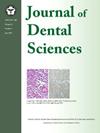老年灼口综合征患者用药增加:一个可能被忽视的危险因素
IF 3.1
3区 医学
Q1 DENTISTRY, ORAL SURGERY & MEDICINE
引用次数: 0
摘要
背景/目的灼口综合征(BMS)是一种慢性口腔黏膜灼烧和疼痛疾病,主要影响中老年妇女。本研究旨在探讨综合用药与BMS之间的关系,并考虑患者的年龄和性别。材料和方法收集115例BMS患者和115例年龄和性别匹配的对照组的医疗资料。根据服用药物的数量将药物分为四组。在调整年龄和性别后,采用卡方检验、学生t检验和二元逻辑回归来评估多药治疗与BMS之间的关系。结果BMS组用药比例高于对照组(P = 0.0015)。BMS患者中,老年人(≥65岁),尤其是女性BMS患者用药倾向较多。二元logistic回归分析显示,多药治疗与BMS发病率增加之间存在显著关联。在调整年龄和性别后,轻度综合用药组(1-4种药物)患者发生BMS的几率明显高于非综合用药组(无药物),调整后的优势比为5.015 (P < 0.001)。结论这些发现提示多种药物治疗与BMS风险之间存在潜在关联,并支持有必要考虑多种药物治疗是老年BMS患者的一个促进因素。然而,未来的研究应进一步探讨确切的剂量-反应趋势和其他相关因素对BMS的影响。本文章由计算机程序翻译,如有差异,请以英文原文为准。
Increased medications in the aged patients with burning mouth syndrome: A potentially overlooked risk factor
Background/purpose
Burning mouth syndrome (BMS) is a chronic oral mucosal burning and pain disorder, predominantly affecting the middle-aged and elderly women. This study aimed to explore the association between polypharmacy and BMS, with consideration of the patients’ age and sex.
Materials and methods
Medical data from 115 BMS patients and 115 age- and sex-matched control subjects were collected. Medications were categorized into four groups based on the number of medications taken. The chi-square test, Student's t-test, and binary logistic regression were performed to evaluate the association between polypharmacy and BMS, after adjustment for age and sex.
Results
A higher proportion of individuals with medications was observed in the BMS group than in the control group (P = 0.0015). Among BMS patients, the older group (≥ 65 years), especially the female BMS patients, tended to take more medications. Binary logistic regression analysis revealed a significant association between polypharmacy and increased odds of having BMS. After adjustment for age and sex, the patients in the minor polypharmacy group (1–4 medications) had significantly higher odds of having BMS compared to those in the non-pharmacy group (no medications), with an adjusted odds ratio of 5.015 (P < 0.001).
Conclusion
These findings suggest a potential association between multiple medications and the risk of having BMS and supported the need to consider polypharmacy as a contributing factor for the older BMS patient. However, future studies should be conducted to explore the exact dose–response trend and the influence of other associated factors on BMS.
求助全文
通过发布文献求助,成功后即可免费获取论文全文。
去求助
来源期刊

Journal of Dental Sciences
医学-牙科与口腔外科
CiteScore
5.10
自引率
14.30%
发文量
348
审稿时长
6 days
期刊介绍:
he Journal of Dental Sciences (JDS), published quarterly, is the official and open access publication of the Association for Dental Sciences of the Republic of China (ADS-ROC). The precedent journal of the JDS is the Chinese Dental Journal (CDJ) which had already been covered by MEDLINE in 1988. As the CDJ continued to prove its importance in the region, the ADS-ROC decided to move to the international community by publishing an English journal. Hence, the birth of the JDS in 2006. The JDS is indexed in the SCI Expanded since 2008. It is also indexed in Scopus, and EMCare, ScienceDirect, SIIC Data Bases.
The topics covered by the JDS include all fields of basic and clinical dentistry. Some manuscripts focusing on the study of certain endemic diseases such as dental caries and periodontal diseases in particular regions of any country as well as oral pre-cancers, oral cancers, and oral submucous fibrosis related to betel nut chewing habit are also considered for publication. Besides, the JDS also publishes articles about the efficacy of a new treatment modality on oral verrucous hyperplasia or early oral squamous cell carcinoma.
 求助内容:
求助内容: 应助结果提醒方式:
应助结果提醒方式:


